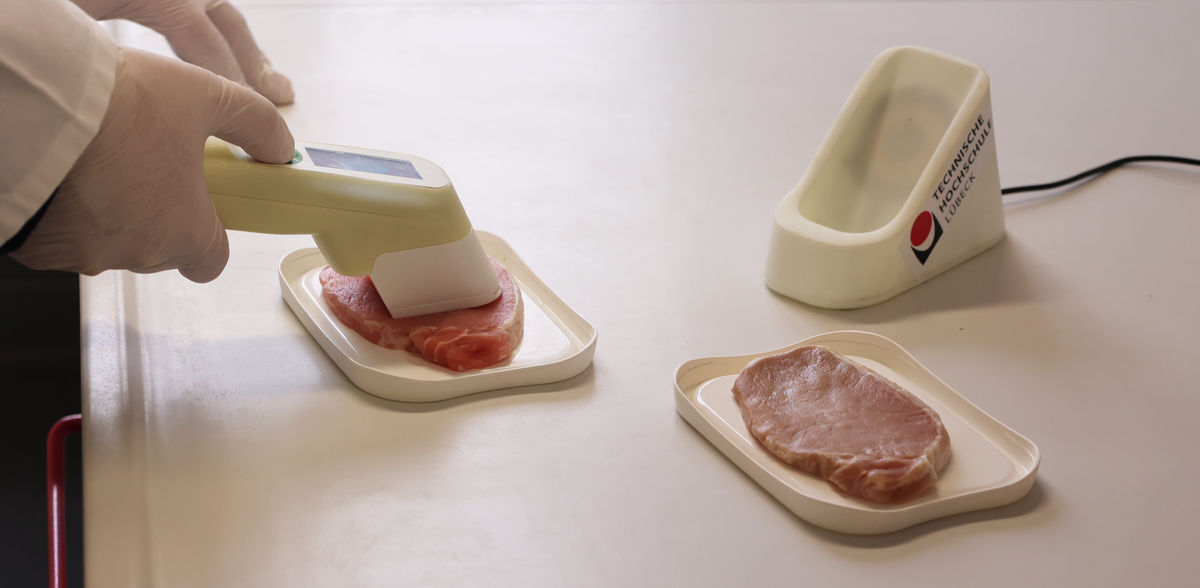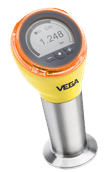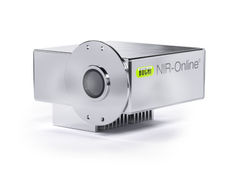PRECISE research project: Electronic nose against food waste
A German-Danish research group is working on a new type of freshness sensor for meat and fish as part of the PRECISE project. The aim of the researchers is to use a new type of "electronic nose" to determine the shelf life of meat and fish and predict it so precisely that tons of food can be saved from being wasted. Experts from TH Lübeck are part of the research project. They are currently testing and optimizing the freshness sensor at the CoSA competence center. The researchers are being funded with 1,885,263 euros until 31.03.2026 as part of the EU Interreg Deutschland-Danmark program.

Sebastian Hauschild prepares a measurement run in the laboratory of the Center for Industrial Biotechnology (CIB).
TH Lübeck
From the human nose to the electronic nose
There are currently two ways of testing whether meat or fish is still edible. On the one hand, trained personnel check the shelf life with their nose and, on the other, there are expensive and time-consuming microbiological analyses, the results of which are only available after days. What is missing is a technical solution that can accurately and quickly determine and predict how long meat and fish will keep. In the German-Danish border region alone, around 48,000 tons of meat and fish waste are produced every year.
"We are required to dispose of meat after a certain period of time. In the case of fish, this is two days, although the fish could actually be eaten for up to nine days," says Sebastian Hauschild, research associate at the CoSA competence center, describing the current situation.
What's that smell?
Roana de Oliveira Hansen, associate professor at the Mads Clausen Institute at Syddansk Universitet (SDU), is leading the project. The professor is working on the development of cantilever sensors at the institute in Sonderborg. Cantilever sensors are thin, flexible beams that deform. In the PRECISE project, they are used to carry out highly sensitive measurements in order to determine the cadaverine content of different types of meat and fish and thus make a statement about the shelf life. "Cadaverine is produced during the decomposition of protein and produces the typical smell of decaying meat," says the professor.
Cantilever sensor
The cantilever sensor is manufactured at the Fraunhofer Institute for Silicon Technology (ISIT), built into the handheld device by Danish startup AmiNIC and handed over to CoSA for testing. "We place the hand-held sensor on the meat. The cadaverine is sucked into the sensor via a fan. An electronic system causes it to vibrate, similar to a diving board in a swimming pool," says Hauschild. "Depending on how many cadaverine peptides stick to the sensor, the oscillation frequency changes. The sensor counts the mass of cadaverine, so to speak. The data obtained is then used to predict the shelf life."
Precise prediction: no looking into a crystal ball
Cadaverine is produced from the first day of slaughter. At this point, humans cannot yet perceive how much cadaverine is contained in the meat or fish. "In future, the electronic nose will take over this job," says Professor Horst Hellbrück, Head of the CoSA Competence Center. "In the project, we have produced a measurement setup on which we test the different types of meat with the freshness sensor and predict the expiry dates using stochastic analyses. We also take into account environmental parameters such as temperature and humidity," explains Sebastian Hauschild.
German-Danish collaboration
Six partners are working together on the project with a common goal: to potentially save 25,000 tons of meat and fish from going to waste. The team led by Roana de Oliveira Hansen from SDU contributes experience in the development of sensors. The CoSA team at TH Lübeck is contributing to the shelf life predictions. The Fraunhofer ISIT in Itzehoe produces the piezoelectric cantilevers. The Danish start-up AmiNIC contributes experience in prototyping, improves the hardware in collaboration with the partners and updates the software based on the data collected by the partners. KIN in Neumünster is also one of the partners. Food safety is a core competence of the KIN and carries out quality control of the measurements with references and safety checks. Flensburg University of Applied Sciences also contributes to this by measuring the bacterial load of fish products.
The future of the cantilever sensor
"Of course, we first have to learn our lessons from the market with larger companies such as restaurants and supermarkets. But in the long term, it could be very interesting to look at how we can make this product available to households," says Jens Nielsen from the start-up AmiNIC with regard to the future of the electronic nose.
Note: This article has been translated using a computer system without human intervention. LUMITOS offers these automatic translations to present a wider range of current news. Since this article has been translated with automatic translation, it is possible that it contains errors in vocabulary, syntax or grammar. The original article in German can be found here.
Other news from the department science
These products might interest you
Most read news
More news from our other portals
See the theme worlds for related content
Topic world Food safety
Food safety is at the heart of the food and beverage industry. It ensures that the food we eat every day is not only nutritious, but also free of harmful contaminants. From field to plate, the industry monitors and regulates every step of the process with strict quality controls, advanced testing methods and continuous research.

Topic world Food safety
Food safety is at the heart of the food and beverage industry. It ensures that the food we eat every day is not only nutritious, but also free of harmful contaminants. From field to plate, the industry monitors and regulates every step of the process with strict quality controls, advanced testing methods and continuous research.




























































